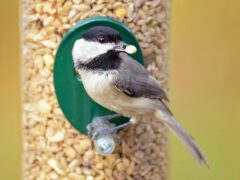American Golden-Plover Photo Gallery
Breeding male
The very long primaries, gold-spangled upperparts, black underparts, and broad white stripe on the head and neck help to identify this shorebird in breeding plumage. The white patch does not extend below the chest, and the flanks and undertail are black, which helps to rule out other species of golden-plovers. In breeding plumage, adult males like this are crisply marked with even black on the face.
© Ian K Barker / Macaulay LibraryManitoba, June 18, 2017Breeding female
A teardrop-shaped shorebird with a large head, slim, short bill, and long legs. In breeding plumage, adult females have pale-mottled faces, giving them a slightly messy look compared to the crisp males.
© Ian Davies / Macaulay LibraryAlaska, June 29, 2013Breeding adult
Common call is a 2- or 3-parted whistle. Like some other plovers, often pauses while running to bob quickly up and back down again.
© Benjamin Clock / Macaulay LibraryAlaska, June 11, 2007Not all videos have soundJuvenile
The large eye and bulky head combine to create a gentle expression. Fall juveniles appear scaly because of their complete set of even-aged, fresh feathers. Four primaries extend beyond the gold-spangled tertials at rest, imparting a longer primary projection to the folded wing than is found on Pacific Golden-Plover or Black-bellied Plover.
© Ryan Sanderson / Macaulay LibraryIndiana, September 21, 2020Juvenile
When viewed head-on, these slim plovers can appear quite plump, but note the long legs and slim bill. Juveniles show a dark cap that contrasts strongly with a pale eyebrow.
© Jeremiah Trimble / Macaulay LibraryNew Hampshire, November 05, 2016Juvenile
The underside of the wing is plain gray, lacking the black "wingpits" shown by Black-bellied Plover.
© Davey Walters / Macaulay LibraryMassachusetts, September 17, 2016Juvenile
Golden-plovers have long, pointed wings and blunt tails. The rump and tail blend in with the back, distinguishing this from the pale-tailed Black-bellied Plover. Also, note the extended legs and feet that fall short of the tip of the tail.
© Steve Kruse / Macaulay LibraryNebraska, September 17, 2020Nonbreeding adult
Nonbreeding birds are similar to juveniles but show drabber upperparts with less crisp feather edging. The long-winged look created by four primaries extending beyond the tertials on the folded wing helps to rule out Black-bellied Plover and other golden-plover species.
© Pablo Re / Macaulay LibrarySanta Fe, December 08, 2020Flock
Golden-plovers fly quickly in wheeling, well-coordinated flocks. Note the slim, pointed wings and pale gray underwings.
© Alex Lamoreaux / Macaulay LibraryIllinois, May 16, 2016Habitat
The erect posture, teardrop-shaped body, blocky head, and slim bill and long legs combine to create the golden-plover “look.” Adults molt into breeding plumage during their marathon spring migration. The black-and-white underparts will become primarily black by the time these birds arrive on their subarctic and arctic breeding grounds.
© Shailesh Pinto / Macaulay LibraryOhio, April 24, 2016Compare with Similar Species
Click on an image to compare
Species in This Family
Plovers and Lapwings(Order: Charadriiformes, Family: Charadriidae)
More to Read
Don't miss a thing! Join our email list
The Cornell Lab will send you updates about birds,
birding, and opportunities to help bird conservation.
















